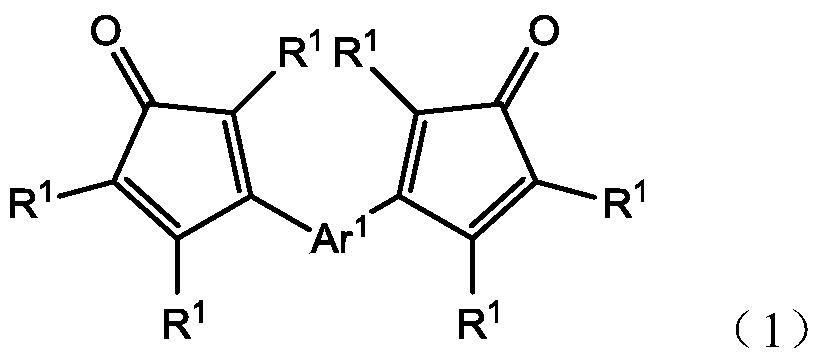Silylated polyarylene
An arylene and aryl technology, applied in the field of polyarylene materials, can solve problems such as incompatibility
- Summary
- Abstract
- Description
- Claims
- Application Information
AI Technical Summary
Problems solved by technology
Method used
Image
Examples
example 1
[0036] Example 1: To a multi-neck round bottom flask with a stir bar was added via a powder funnel diphenylene oxide bis(triphenylcyclopentadienone) (DPO-CPD, 2.75 g, 3.52 mmol) followed by alkyne monomer 1, 3-Bis[(trimethylsilyl)ethynyl]benzene (1,3-TMS-DEB, 1.00 g, 3.70 mmol) and reaction solvent γ-butyrolactone (GBL, 20 g, 16% solids). The reaction was stirred gently at room temperature to obtain a homogeneous mixture. The flask was then equipped with a reflux condenser and an internal thermocouple probe attached to a self-regulating thermostat attached to a heating mantle. The dark maroon contents of the flask were warmed to an internal temperature of 205°C and maintained at this temperature for 96 hours, then cooled to room temperature by removing the heating element. The resulting dark maroon solution was transferred to a vial. Gel permeation chromatography on this crude mixture reveals that M n = 5362 Da and M w = Peak molecular weight distribution of 6678 Da.
[...
example 2
[0040] Example 2: The procedure of Example 1 was repeated except that the solvent was benzyl propionate.
example 3
[0041] Example 3: To a multi-neck round bottom flask with a stir bar was added diphenylene oxide bis(triphenylcyclopentadienone) (2.75 g, 3.52 mmol) followed by 1,3-bis[(trimethoxy silyl)ethynyl]benzene (1.36 g, 3.72 mmol) and the reaction solvent N-methylpyrrolidone (25 g). The reaction was stirred gently at room temperature to obtain a homogeneous mixture. The flask was then equipped with a reflux condenser and an internal thermocouple probe attached to a self-regulating thermostat attached to a heating mantle. The contents of the flask were warmed to an internal temperature of 195°C and maintained at this temperature for 96 hours before the heating element was removed.
PUM
| Property | Measurement | Unit |
|---|---|---|
| thickness | aaaaa | aaaaa |
| thickness | aaaaa | aaaaa |
Abstract
Description
Claims
Application Information
 Login to View More
Login to View More - R&D
- Intellectual Property
- Life Sciences
- Materials
- Tech Scout
- Unparalleled Data Quality
- Higher Quality Content
- 60% Fewer Hallucinations
Browse by: Latest US Patents, China's latest patents, Technical Efficacy Thesaurus, Application Domain, Technology Topic, Popular Technical Reports.
© 2025 PatSnap. All rights reserved.Legal|Privacy policy|Modern Slavery Act Transparency Statement|Sitemap|About US| Contact US: help@patsnap.com



